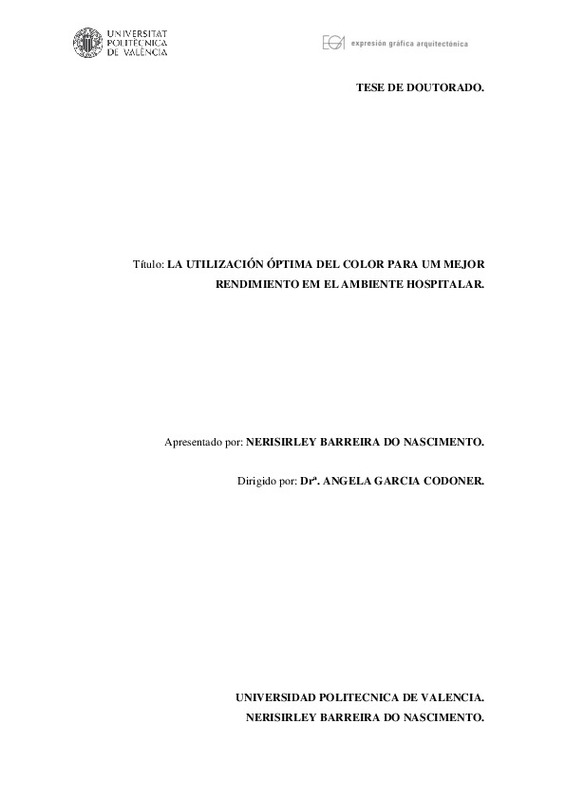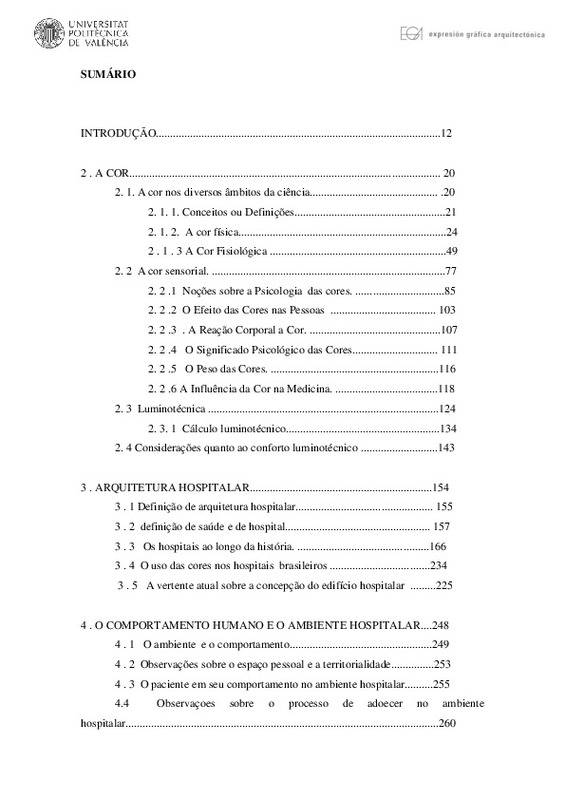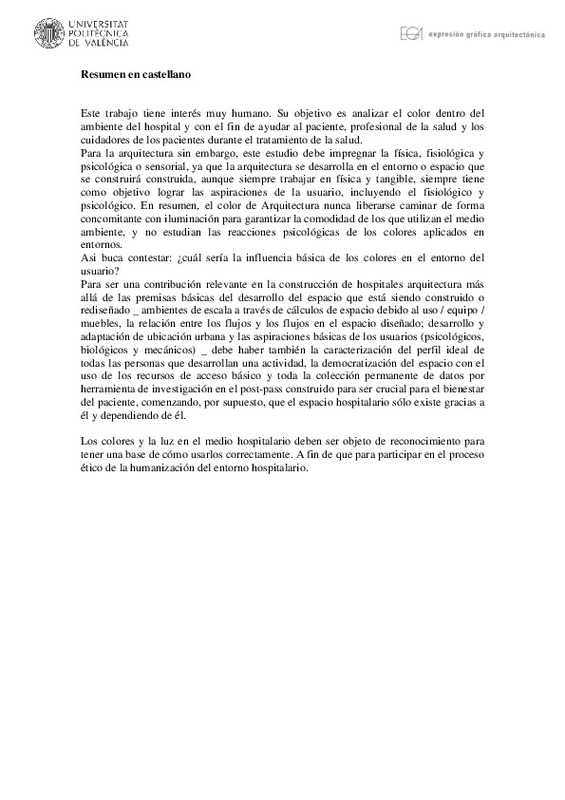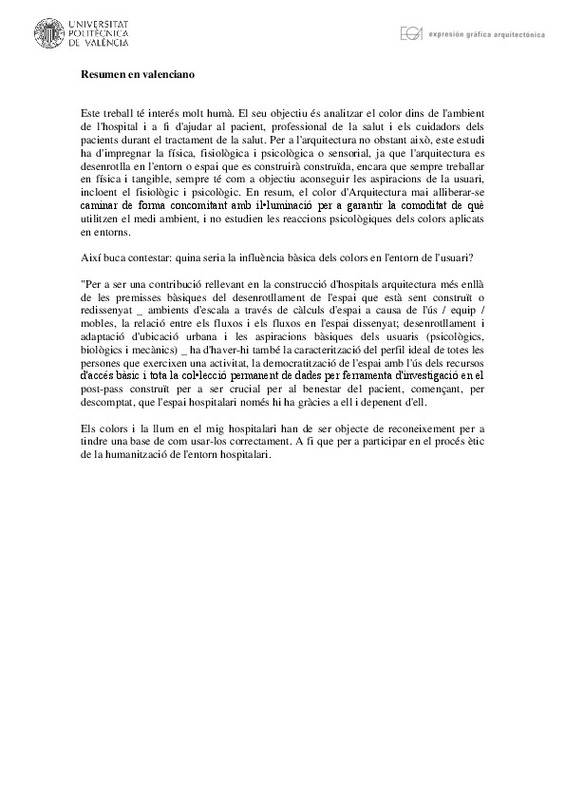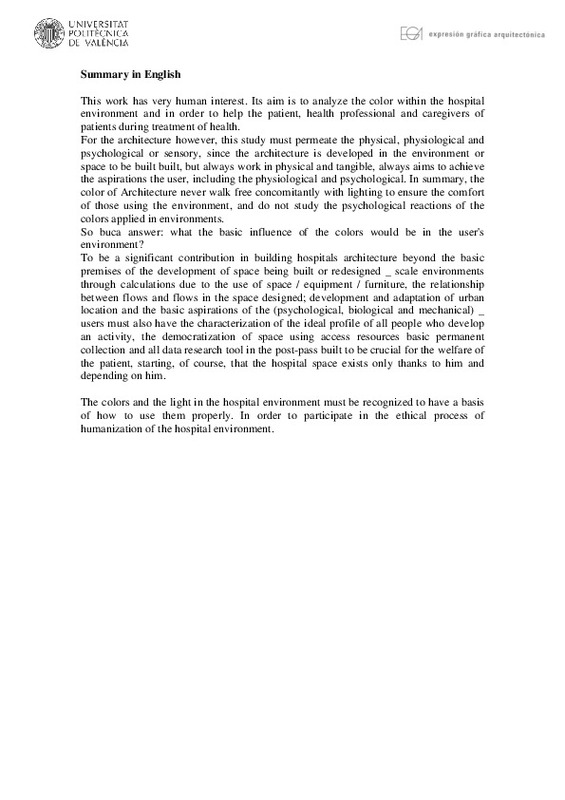- RiuNet repositorio UPV
- :
- Investigación
- :
- Tesis doctorales
- :
- Ver ítem
JavaScript is disabled for your browser. Some features of this site may not work without it.
Buscar en RiuNet
Listar
Mi cuenta
Estadísticas
Ayuda RiuNet
Admin. UPV
LA UTILIZACIÓN ÓPTIMA DEL COLOR PARA UM MEJOR RENDIMIENTO EM EL AMBIENTE HOSPITALAR
Mostrar el registro sencillo del ítem
Ficheros en el ítem
| dc.contributor.advisor | García Codoñer, Ángela
|
es_ES |
| dc.contributor.author | Barreira Do Nascimento, Nerisírley
|
es_ES |
| dc.date.accessioned | 2015-10-08T05:39:07Z | |
| dc.date.available | 2015-10-08T05:39:07Z | |
| dc.date.created | 2015-09-22 | es_ES |
| dc.date.issued | 2015-10-08 | es_ES |
| dc.identifier.uri | http://hdl.handle.net/10251/55763 | |
| dc.description.abstract | [EN] This work has very human interest. Its aim is to analyze the color within the hospital environment and in order to help the patient, health professional and caregivers of patients during treatment of health. For the architecture however, this study must permeate the physical, physiological and psychological or sensory, since the architecture is developed in the environment or space to be built built, but always work in physical and tangible, always aims to achieve the aspirations the user, including the physiological and psychological. In summary, the color of Architecture never walk free concomitantly with lighting to ensure the comfort of those using the environment, and do not study the psychological reactions of the colors applied in environments. So buca answer: what the basic influence of the colors would be in the user's environment? To be a significant contribution in building hospitals architecture beyond the basic premises of the development of space being built or redesigned _ scale environments through calculations due to the use of space / equipment / furniture, the relationship between flows and flows in the space designed; development and adaptation of urban location and the basic aspirations of the (psychological, biological and mechanical) _ users must also have the characterization of the ideal profile of all people who develop an activity, the democratization of space using access resources basic permanent collection and all data research tool in the post-pass built to be crucial for the welfare of the patient, starting, of course, that the hospital space exists only thanks to him and depending on him. The colors and the light in the hospital environment must be recognized to have a basis of how to use them properly. In order to participate in the ethical process of humanization of the hospital environment. | en_EN |
| dc.description.abstract | [ES] Este trabajo tiene interés muy humano. Su objetivo es analizar el color dentro del ambiente del hospital y con el fin de ayudar al paciente, profesional de la salud y los cuidadores de los pacientes durante el tratamiento de la salud. Para la arquitectura sin embargo, este estudio debe impregnar la física, fisiológica y psicológica o sensorial, ya que la arquitectura se desarrolla en el entorno o espacio que se construirá construida, aunque siempre trabajar en física y tangible, siempre tiene como objetivo lograr las aspiraciones de la usuario, incluyendo el fisiológico y psicológico. En resumen, el color de Arquitectura nunca liberarse caminar de forma concomitante con iluminación para garantizar la comodidad de los que utilizan el medio ambiente, y no estudian las reacciones psicológicas de los colores aplicados en entornos. Asi buca contestar: ¿cuál sería la influencia básica de los colores en el entorno del usuario? Para ser una contribución relevante en la construcción de hospitales arquitectura más allá de las premisas básicas del desarrollo del espacio que está siendo construido o rediseñado _ ambientes de escala a través de cálculos de espacio debido al uso / equipo / muebles, la relación entre los flujos y los flujos en el espacio diseñado; desarrollo y adaptación de ubicación urbana y las aspiraciones básicas de los usuarios (psicológicos, biológicos y mecánicos) _ debe haber también la caracterización del perfil ideal de todas las personas que desarrollan una actividad, la democratización del espacio con el uso de los recursos de acceso básico y toda la colección permanente de datos por herramienta de investigación en el post-pass construido para ser crucial para el bienestar del paciente, comenzando, por supuesto, que el espacio hospitalario sólo existe gracias a él y dependiendo de él. Los colores y la luz en el medio hospitalario deben ser objeto de reconocimiento para tener una base de cómo usarlos correctamente. A fin de que para participar en el proceso ético de la humanización del entorno hospitalario. | es_ES |
| dc.language | Portugués | es_ES |
| dc.publisher | Universitat Politècnica de València | es_ES |
| dc.rights | Reserva de todos los derechos | es_ES |
| dc.subject | Color | es_ES |
| dc.subject | Luz | es_ES |
| dc.subject | Arquitectura de Hospitales | es_ES |
| dc.subject | Confort ambiental | es_ES |
| dc.subject | Psicología Sensorial | es_ES |
| dc.subject | Fisiología | es_ES |
| dc.subject | Diseño gráfico. | es_ES |
| dc.subject.classification | EXPRESION GRAFICA ARQUITECTONICA | es_ES |
| dc.title | LA UTILIZACIÓN ÓPTIMA DEL COLOR PARA UM MEJOR RENDIMIENTO EM EL AMBIENTE HOSPITALAR | es_ES |
| dc.type | Tesis doctoral | es_ES |
| dc.identifier.doi | 10.4995/Thesis/10251/55763 | es_ES |
| dc.rights.accessRights | Abierto | es_ES |
| dc.contributor.affiliation | Universitat Politècnica de València. Departamento de Expresión Gráfica Arquitectónica - Departament d'Expressió Gràfica Arquitectònica | es_ES |
| dc.description.bibliographicCitation | Barreira Do Nascimento, N. (2015). LA UTILIZACIÓN ÓPTIMA DEL COLOR PARA UM MEJOR RENDIMIENTO EM EL AMBIENTE HOSPITALAR [Tesis doctoral]. Universitat Politècnica de València. https://doi.org/10.4995/Thesis/10251/55763 | es_ES |
| dc.description.accrualMethod | TESIS | es_ES |
| dc.type.version | info:eu-repo/semantics/acceptedVersion | es_ES |
| dc.relation.pasarela | TESIS\9172 | es_ES |
Este ítem aparece en la(s) siguiente(s) colección(ones)
-
Tesis doctorales [5389]






